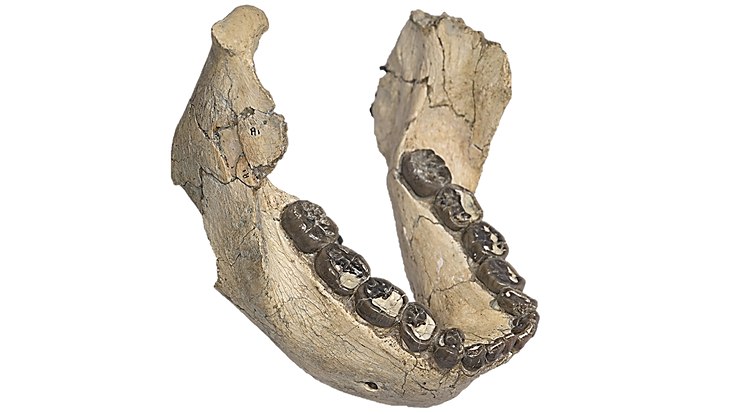
Climate Change Has Influenced Human Evolution Differently Than Previously Thought
25 May 2020

Photo: UHH/CeNak, Kaiser; National Museum and House of Culture, Daressalaam
The Peninj 1 mandible from Lake Natron (Tanzania) is amazingly robust and is one of the best preserved fossils known of the hominin species Paranthropus boisei. Nevertheless, 1.5 million years ago, its owner had no particular preference for the brittle and hard foods of the savanna.
The food our human ancestors ate usually reveals a lot about their environment. Climate change 2.8 million years ago must have also left its mark because this is the first time that our genus Homo appears in fossil records. Other hominids who lived at the same time were thought to be able to defy the drier climate by eating hard-shelled fruits and nuts and leaving the ecological niche of the omnivore to humans. This assumption was questioned by a team led by Thomas Kaiser, professor and head of the CeNak Department of Mammalogy and Paleoanthropology. But what did our human ancestors eat and how can researchers find this out?
In his current study, Thomas Kaiser has reconstructed the food preferences of hominids. Together with his research team, he studied the mechanical properties of 12 well-preserved fossil mandibles representing various hominin species to find out how hard or soft their meals had been. The study was recently published in Nature Scientific Reports.
While looking at the robust mandible of Australopithecines, for example, the “Nutcracker man” Paranthropus boisei, researchers had believed that this species must be hard-food eaters because it has the largest teeth and the most powerful chewing muscles of all hominins. What would be the purpose, if not for chewing hard food? Previously, this had been the obvious conclusion. But was Paranthropus boisei really a nutcracker? To answer this question, the team used a step-by-step process to examine 12 well-preserved fossil mandibles.
First, they started by conducting a morphometric analysis of the mandible fossiles. The objects were photographed and the contours then digitized and transferred to a specially developed coordinate system. From the deviation that results when the distances of corresponding surface points were compared in a computer model, parameters for a similar shape can be calculated.
The study also included 30 models of extant primate species as a reference, including apes. Biologists know exactly whether these species eat hard foods or avoid them. In a direct comparison, it was possible to determine the position in the coordinate system where the mandibles of the hominins appear together with those of the other primate species and thus the mandible structures of our human ancestors that were mechanically most suitable for which food.
In addition, the study used finite element analysis. The researchers simulated natural biting, for which models of the muscular forces first had to be reconstructed. Then the loads that the jaws experience were virtually applied by simulating biting at 4 different tooth positions. Hard food always causes higher levels of stress in the mandibles, and these stress levels were collected in an index so that they could be directly compared.
All of the analyses led the researchers to the startling conclusion that Paranthropus boisei did not eat hard food—despite its massive mandibles. In no other hominin species in this study were these results so clearly different fromwhat was previously believed. However, later hominin species turned out to be mainly food generalists that did not specialize in a certain food hardness. Only the Asian homo erectus from China showed a tendency toward eating hard food.
The study provides an important basis for evolutionary research on human species that are between half a million and 3.5 million years old and challenges previous hypotheses on the effect of climate change on our evolution. It provides new insight into why the evolutionary paths of some hominin species parted ways more than 2 million years ago when climate change caused Africa to become drier.
Further information
- CeNak Department of Mammalogy and Paleoanthropology
- Broad-scale morpho-functional traits of the mandible suggest no hard food adaptation in the hominin lineage; Jordi Marcé-Nogué, Thomas A. Püschel, Alexander Daasch & Thomas M. Kaiser.
Contact
Prof. Dr. Thomas M. Kaiser
Head of Department for Mammalogy and Paleoanthropology
Center of Natural History (CeNak)
Universität Hamburg
Tel: +49 40 42838-7653
Thomas.Kaiser"AT"uni-hamburg.de
